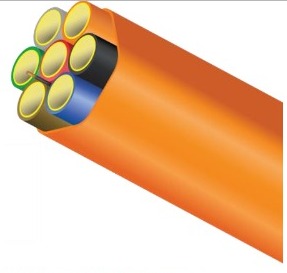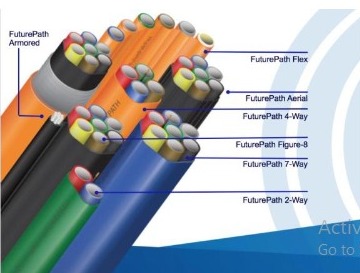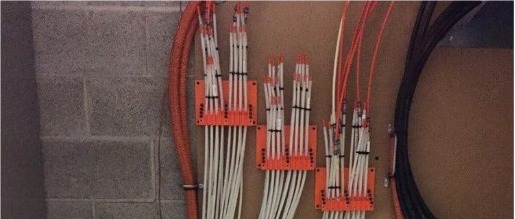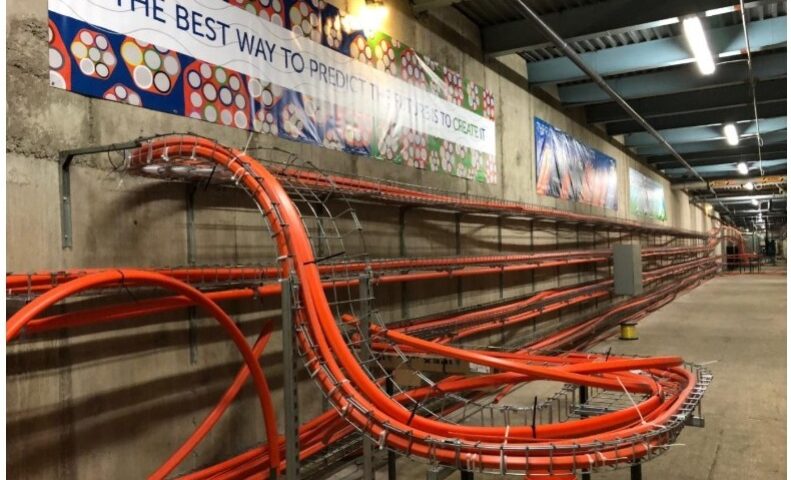As communications infrastructure continues to evolve rapidly, maximizing flexibility, scalability, and
efficiency is crucial for both enterprise and residential-type commercial premises. The deployment of air- blown fiber is a crucial innovation in this space, allowing organizations to install and upgrade fiber optic networks with unparalleled ease and future-proofing. Dura-Line, a leading pathway manufacturer, offers conduit systems, paired with air-blown fiber technology, which provide significant advantages for premise environments. Specific applications stand to greatly benefit from these technologies.
Dura-Line: A Leader in Pathway Solutions
Metro Sales Solutions is delighted to represent Dura-Line, a global manufacturer known for its cutting- edge infrastructure products designed for deploying fiber optic cable. Their products include high-performance conduits, ducts, and pathway systems that facilitate the installation of fiber optic cable in a variety of environments, ranging from long-distance outdoor network to in-building cabling.
Dura-Line’s pathway products are designed to protect fiber while ensuring ease of installation and scalability. Key features include:
- High Density Polyethylene (HDPE) Conduit: Provides a robust, flexible protective casing for fiber installations. HDPE conduits are resistant to environmental factors such as temperature variations, moisture, and physical damage.
- MicroDuct Solutions: These small, flexible conduits are optimized for air-blown fiber installations in premise environments. They enable incremental fiber deployment without the need for disruptive excavation or infrastructure overhauls.

- FuturePath Technology: FuturePath solutions are multi-cell conduits designed to house multiple cables within a single conduit. This allows for additional fiber deployment without the need for installing additional pathways, significantly reducing the cost and complexity of future expansions.
Air-Blown Fiber Technology: Overview and Benefits
Air-blown fiber (ABF) is an innovative solution for deploying optical fiber in a flexible, cost-effective manner. In this system, fiber cables (or bundles of fiber) are blown through pre-installed ducts using compressed air. This contrasts with traditional methods where fiber is manually pulled through conduits.

Advantages of Enterprise Air-Blown Fiber (eABF) in Premise Environments
- Scalability: One of the biggest advantages of eABF is its ability to scale easily. Rather than installing all the fiber at once, organizations can blow additional fiber into pre- installed conduits as needed, helping to manage upfront costs while accommodating highly growth in network capacity.

- Minimal Disruption: For premise environments—especially office buildings, hospitals, and data centers—minimizing disruption during upgrades or expansions is critical. Since the ducts are pre- installed, additional fiber can be deployed without the need to remove or modify existing cabling, avoiding service downtime and reducing installation time.
- Flexibility for Upgrades: As technology advances and fiber needs to evolve, eABF systems offer an easy way to upgrade or replace older fiber without having to overhaul the complete physical infrastructure. This is especially important as bandwidth requirements grow with newapplications like AI optimized software at the edge, 5G backhaul, cloud services, and IoT networks.
- Reduced Initial Capital Expenditure: With eABF, organizations can install the conduits for future fiber during initial construction without having to deploy all the fiber at once. This staged approach allows companies to defer some of the upfront capital expenditures and spread costs over time as network demands increase.
- Improved Future-Proofing: With Dura-Line’s FuturePath and Override MicroDuct solutions, eABF provides a future-proof approach to network expansion. The small diameter of MicroDucts means that organizations can easily add or replace fiber without major physical modifications to their infrastructure, ensuring the network can evolve with technology without excessive cost or downtime.
- Simplified Network Architecture: By combining Dura-Line’s modular pathway systems with eABF, network architecture can be simplified. Instead of relying on complex splicing and terminations, ABF allows for continuous runs of fiber between endpoints, reducing the risk of signal loss and improving overall network performance.
Key Applications of Air-Blown Fiber in Premise Networks
While the advantages of air-blown fiber make it suitable for a wide range of environments, certain applications benefit most from its flexibility and scalability. Below are some key areas where eABF is especially valuable:
1. Data Centers:
- High-Density Deployments: Modern data centers require vast amounts of fiber to support high-speed networking between servers, storage, and switching equipment. eABF allows for easier expansion of fiber capacity as new racks and equipment are added without causing downtime or compromising the integrity of existing cabling.
- Low Latency, High-Bandwidth Connectivity: The ability to add additional fiber links quickly and easily helps datacenters keep up with the growing demand for low-latency, high-bandwidth connections required by modern applications like artificial intelligence, machine learning, and big data analytics.
2. Corporate Office Buildings:
- Landlord Owned Backbone Infrastructure: Most landlords provide riser capacity for tenants to connect their own internet service, but often there is hardship in lack of presence from desired ISPs, build costs being prohibitive, and timelines to deploy being longer than anticipated. Alternatively, a building owned FuturePath backbone would allow landlords to act like a utility, leasing out pathways and fiber, deploying fiber as needed, generating revenue, and requiring ISPs to simply populate Meet-Me Rooms for plug and play services, making the tenant service procurement process exceedinglysimple – a significant differentiator.
- Flexible Office Reconfigurations: As businesses grow and reorganize, network infrastructure must evolve to accommodate changing space usage. eABF allows organizations to add or move fiber quickly, without requiring large-scale physical reconfiguration of existing wiring closets or pathways.
- Reduced Lifecycle Costs: The ability to upgrade or replace fiber without needing to rip and replace cabling helps lower the total cost of ownership (TCO) for corporate networks, especially in large office buildings.
3. Transportation Facilities:
- Future-Proof Infrastructure with Scalability and Flexibility: Transportation systems like airports, railways, and smart roads evolve rapidly, requiring networks that can easily scale to accommodate new technologies. eABF allows fiber to be blown into pre- installed MicroDucts only when needed, providing on-demand scalability without additional excavation or major disruption. This ensures that transportation facilities arealways ready for future technology upgrades, including IoT devices, smart sensors, and advanced communication systems.
- Minimizing Operational Disruptions and Reducing Costs: In busy transportation hubs, downtime can be expensive and disruptive to both operations and the passenger experience. eABF reduces operational interruptions by enabling network upgrades and repairs with minimal interference, as fibers can be blown in or replaced quickly through the existing MicroDucts infrastructure. This eliminates the need for costly trenching and major network rebuilds, ensuring smooth operations while controlling maintenance budgets.
- Enhancing Network Reliability and Performance for Critical Systems: Airports, railway stations, and intelligent traffic systems rely on robust, low-latency networks to manage everything from surveillance cameras and security systems to public information displays. eABF ensures high-performance fiber networks meet the growing demands for real-time data, enabling smooth and reliable operations.
4. Healthcare Facilities:
- Critical, High-Reliability Applications: Healthcare facilities often rely on uninterrupted network connectivity for critical applications like electronic medical records (EMR),telemedicine, and real-time imaging. eABF’s ability to deploy fiber with minimal downtime makes it an ideal solution for expanding or upgrading networks in these environments.
- Compliance with Infection Control Standards: Healthcare facilities must adhere to strict regulations regarding infection control and the installation and maintenance of network infrastructure. eABF helps ensure that network upgrades can be performed while minimizing disruption to patient care areas and plenum return spaces, ensuring significant reduction of contamination risks and compliance with Joint Commission (JCAHO) and other regulatory requirements.
5. Educational Institutions:
- Campus Networks: Schools and universities often need to extend network capacity across sprawling campuses with multiple buildings. eABF provides an efficient way to connect these buildings while offering future scalability for the growing bandwidth demands driven by online learning platforms and research.
- Cost-Effective Expansion: As student and faculty needs change, eABF enables schools to expand their network infrastructure without having to conduct major renovations or disrupt ongoing operations.
6. Smart Buildings:
- IoT and Building Automation: Smart buildings rely on a network of sensors, cameras, and control systems to optimize energy use, security, and operations. eABF provides the high-speed backbone required to support these systems, offering the flexibility to add more sensors or upgrade as needed.
7. Artificial Intelligence:
- Unknown Bandwidth Demands: Artificial Intelligence has exploded in the last couple of years and even with the hundreds of billions of dollars already invested, we’re still only in the Core Model training phase. In a relatively short timeframe, AI will begin to overlay and augment the vast majority of enterprise software systems at the edge, rewriting infrastructure demands as we know them. eABF offers the most efficient and effective way to future-proof against exploding bandwidth demands of unknown AI applications.
Conclusion
Dura-Line’s comprehensive range of HDPE conduits and MicroDuct systems is a key part of Metro Sales Solutions’ go-to-market strategy. When combined with air-blown fiber technology, Dura-Line offers premise environments unparalleled flexibility, scalability, and cost-efficiency. From data centers to
residential high-rise buildings, and healthcare facilities to transportation facilities, this combination addresses the ever-increasing demands for high-bandwidth, low-latency connections while providing a future-proof solution for network growth.
As network infrastructure continues to evolve, the ability to deploy and upgrade fiber in a seamless, cost-effective manner is essential for maintaining competitiveness. Organizations looking to build or
enhance their network infrastructure should consider leveraging Dura-Line’s pathway solutions and air- blown fiber technology to future-proof their networks while reducing both initial and long-term costs.



